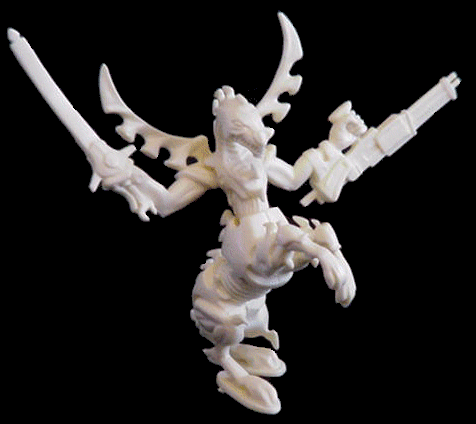
|
|
| 2 Players | 30-60 minutes |
|
Concept: Combine elements of
Checkers, Backgammon, and Chess -- race to move your pieces to
the finish or trap your opponent's king to win. |
|
|
Gameplay: The goal of the game (in
general) is to move your pieces to the other end of the board following
a zig-zag path. The path is best described by looking at the quick
reference card provided, but basically alternates solid color (matching
the player) and intersection of squares. Players have two types of
pieces at their disposal -- regular pieces and a king. Kings may
move backwards at any space on the board, and count as a stack of two
normal pieces. Each player's turn has two
phases:
On each turn, the player
rolls their two 6-sided dice. Players may move pieces based upon
the number rolled. Like Backgammon, each die may represent the
movement of separate pieces, or may be combined to move a single piece.
A roll of doubles allows double movement ( ex. double 3s will yield
four movements of 3.) Pieces may only enter the finish section of the
board by an exact count, and once they arrive in the finish, they
cannot leave. As with Backgammon, if all of your
pieces are within 5 spaces of the finish, then you may move the
furthest piece into finish when you roll a 6. Check the official rules
for the full explanation. During the dice movement
phase, you may use your pieces to attack your opponent. If you
land on an intersection occupied by your opponent's piece(s), their
pieces are sent back to start. However, in order to do this, you must
land on the intersection with the same number (or more) of pieces as
your opponent. You may stack up to four pieces
together at a time. If you attack an opposing
king, the king will not be sent back to start, rather it is flipped and
changes to your control. If a player successfully
uses all of their dice movement, they may enter a jumping phase.
One piece (or one stack of pieces) may jump per turn. You may only jump
over your own pieces that are located on intersections of the board. You may not jump out of start or
into the finish area. The first player who moves
all of their pieces to the finish, wins. However, there is an
alternate method of winning. If you capture your opponent's king
in a configuration called a chebache, you end the game. A chebache is formed when
you control three consecutive points on the board in the form of
intersection, solid color, intersection. The chebache formation causes
two things to occur. First, your opponent may not land on the space
controlled by the chebache formation -- (usually an adjacent solid
color space). Second, if there are pieces trapped in the
chebache, your opponent has one turn to move them, or break the
chebache -- otherwise the pieces are returned to start. If the trapped
piece is a king -- the game ends and you win! The chebache
formation may be broken by attacking either of the intersections of the
chebache. |
|
| Winning Conditions:
|
|
| Our Opinion:
The most difficult part of
this game is the movement pattern. The serpentine path takes some
getting used to, and it often leads beginners into some strategic
errors. Once you get used to the path, the game really takes form. Strategically, players must
decide between a few tactics -- consolidate your pieces into a few
stacks, race for the finish no matter what, or work to maintain a chain
of chebache formations to contain your opponent. When you figure
in the roll of the dice, the tactical choices can change every turn. This game on the surface
feels like backgammon -- and if you play the game simply, you can play
it just like backgammon. The biggest two differences that this
game brings compared to backgammon is the fact that no stack of pieces
on an intersection is ever safe from attack, and that pieces can
sometimes move backwards! When you use these abilities, the game
changes drastically from backgammon. Overall, we liked the
game. It's well designed and balanced. The box version is well
constructed and has a clean presentation that merits the price.
For fans of backgammon-like games, this is an excellent choice. There is an online version
of the game, if you'd like to try it before ordering the box version.
Details can be found at the Chebache
website. We didn't evaluate this version -- but it may be a
good starting point if you are curious about the game. |
|
| Where to buy: Visit www.chebache.com. It costs
about US $30. |
|
 Other Reviews Other Reviews |
Zombie Main page |
|
|